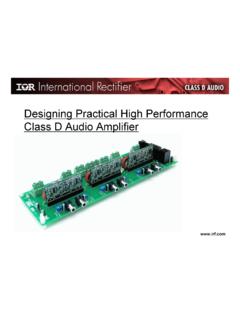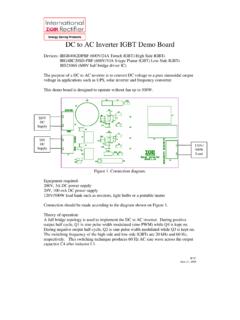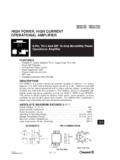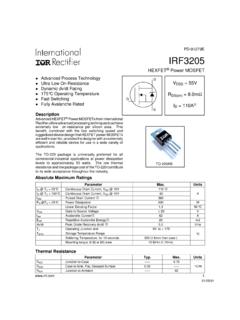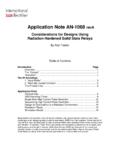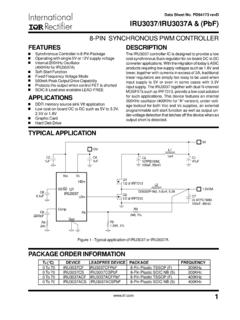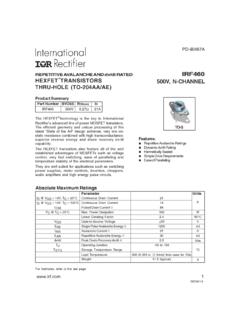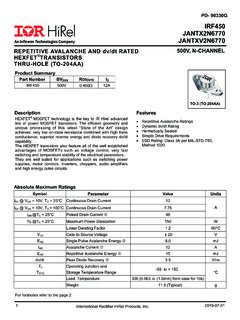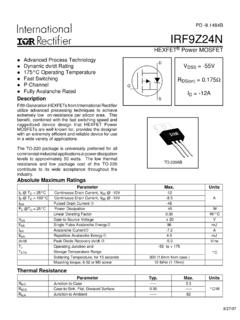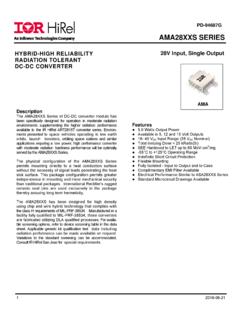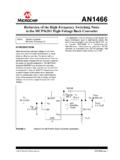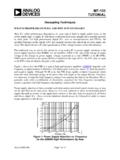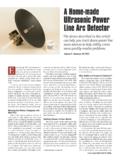Transcription of IGBT reverse conduction characteristics Hard …
1 COMPANY CONFIDENTIAL18 igbt reverse conduction characteristicsHard- switching and soft-switchingEnergy Saving Products BUJuly 2013 COMPANY CONFIDENTIAL19 The igbt in reverseThe igbt is a four-layer structure (P-N-P-N).It has a well-defined blocking capability in one direction and a weak and undefined blocking capability in the reverse in topologies with reverse conducting requirements (bridge) need an anti-parallel diode, normally co-packaged with the topologies (boost PFC) do not require an anti-parallel series blocking diode must be added to IGBTs (and FETs) if the topology requires reverse blocking capability (current-fed converters).The MOSFET is a three-layer structure (N-P-N) with good reverse conduction more details follow the link below to appnote AN-983, Section 1, AN-983 COMPANY CONFIDENTIAL20 Advantages and disadvantages compared to a MOSFETThe diode co-packaged with the igbt is targeted to the MOSFET integral rectifier has a low voltage drop but reverse recovery characteristics are inadequate for high frequency co-packages three different types of diodes targeted to the application.
2 - Very low voltage dropfor resonant and ZVS converters to minimize diode conduction losses- Very soft recoveryfor motor drives to minimize EMI- Very low stored chargefor high frequency applications to minimize recovery and turn-on lossesCOMPANY CONFIDENTIAL21 Soft- switching v. hard -switchingSoft- switching The diode co-packaged with the igbt conducts beforethe igbt turns on, on account of the resonant nature of the the igbt turns on, it has only a diode drop between emitter and collector. The turn-on losses are virtually zero. See example in next allows operation at higher examples: induction heating and some power the igbt turns on load current is flowing in the antiparallel diode of a complementaryIGBT. At turn-on the igbt picks up the load current plus the reverse recovery current of the diode.
3 See waveform of the reverse recovery of the diode turn-on losses are normally higher than turn-off power converters and motor drives operate in this CONFIDENTIAL22 Soft- switching example Series Resonant Half-bridge converter (SRHB)The pink trace is the voltage at the midpoint. The blue trace is the current in a has no reverse recovery losses because load current transfers from the diode to the antiparallel igbt with a very low di/dt <10A/ s (ZVS). During the diode reverse recovery load current flows in the igbt and in the diode (as reverse recovery current). TRRis normally <1 s in these operating conditionsDiode VFRis the important parameter. A large diode VFRincreases lossesCOMPANY CONFIDENTIAL23 hard - switching example When the turns on, load current transfers:- to igbt - from freewheeling diodeReverse recovery currentIGBT turn-on energyHigher reverse recovery charge means higher igbt turn-on lossesDiode has its own recovery losses, as well.
4 They can be higher or lower than the igbt turn-on losses, depending on diode and currentCOMPANY CONFIDENTIAL24 Soft recovery v. hard recovery Di/dt during the second half of the reverse recovery measures softness A diode with high di/dt is called snappy . Frequently this di/dt is the highest di/dt in the circuit. It induces noise in the logic and generates during second half of the reverse recoveryIncreasing gate drive impedance at turn-on has a small beneficial effect. It normally increases turn-on few manufacturers provide data on softness
